Dinosaur Isle
Dinosaur Isle is a purpose-built dinosaur museum located in Sandown on the Isle of Wight in southern England.[1]
The outside of Dinosaur Isle. | |
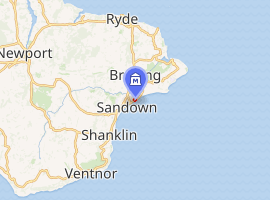
| |
| Established | 2001 |
|---|---|
| Location | Sandown, Isle of Wight |
| Type | Paleontological |
| Visitors | 60 000 |
| Director | Martin Munt |
| Curator | Steve Hutt |
| Website | Dinosaurisle |
The museum was designed by Isle of Wight architects Rainey Petrie Johns in the shape of a giant pterosaur.[2] It claims to be the first custom-built dinosaur museum in Europe.
History
Throughout the 19th century, many collectors such as the Reverend William Fox (1813-1881) exhumed the types of new species: Aristosuchus, Hypsilophodon foxii, Polacanthus... Most of the discoveries then left the island's territory, which is why, the Isle of Wight Council began its own collection.
In 1914 the Isle of Wight's first geological museum opened in Sandown.[3]
The £2.7 million cost of Dinosaur Isle, the new museum, was provided by Isle of Wight Council and the National Lottery Millennium Commission.[4] Dinosaur Isle opened to visitors on 10 August 2001. It currently houses 40,000 specimens, including nearly 200 types. The museum offers many field trips to discover the island's main palaeontological sites.
Exhibits
The visit to the museum begins with a presentation of the different past ecosystems that can be found in different parts of the island.
The large central room is dedicated to dinosaurs. Many life-size replicas and models are found there, including Ornitischians: Iguanodon, Polacanthus and Hypsilophodon as well as saurischians like Eotyrannus, or Neovenator - Neovenator salerii was discovered in 1978 and described by Steve Hutt[5] one of the curators of the museum.
The skeleton of the Iguanodon Pink Iggy is particularly interesting. It was discovered in 1976 by Steve Hutt in an almost anatomical position.
On one of the walls of the room, reconstructions of heads of different pterosaurs are displayed. Indeed, the museum houses the holotype of Caulkicephalus[6]
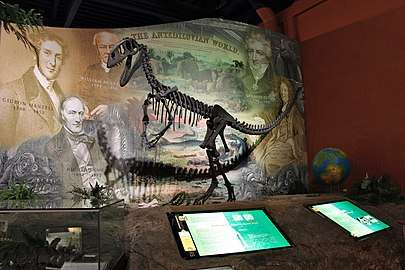 First discoveries of Dinosaurs in England
First discoveries of Dinosaurs in England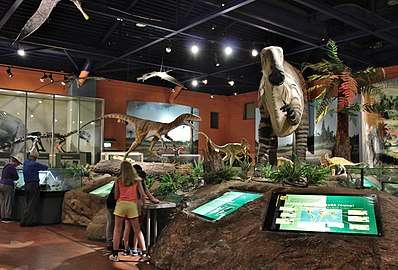 Dinosaur Hall
Dinosaur Hall [Hypsilophodon foxii life size model on display
[Hypsilophodon foxii life size model on display
Guests are given the opportunity to speak to experts and watch them at work.
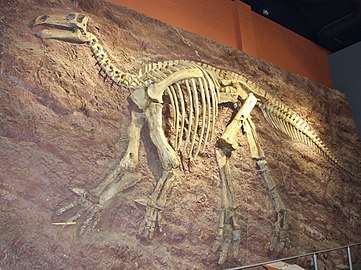 Pink Iggy, Iguanodon skeleton
Pink Iggy, Iguanodon skeleton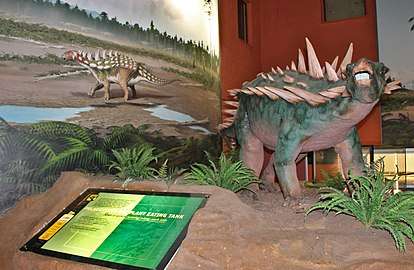 Polacanthus foxi life size model on display
Polacanthus foxi life size model on display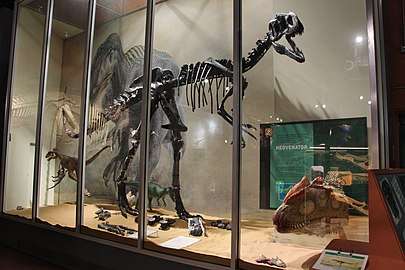 Neovenator Salerii discovered in 1978 in the isle of Wight
Neovenator Salerii discovered in 1978 in the isle of Wight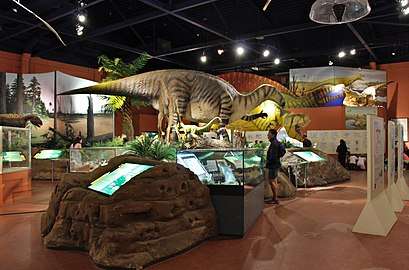 Dinosaur Hall
Dinosaur Hall
See also
References
- "Things to do in South East England - Dinosaur Isle". www.visitsoutheastengland.com. Archived from the original on 29 September 2011. Retrieved 15 December 2008.
- "Enjoy England - Dinosaur Isle". www.enjoyengland.com. Retrieved 15 December 2008.
- Munt (2008). A history of geological conservation on the Isle of Wight. Geological Society, London, Special Publications. p. 173,179.
- "Dinosaur Isle official website - About Us". www.dinosaurisle.com. Archived from the original on 12 October 2008. Retrieved 2008-12-15.
- Hutt, S. Martill, D. M. & Barker, M. J. (1996). The first European allosaurid dinosaur (lower Cretaceous, Wealden Group, England). N. Jb. Geol. Paläont. Mb, 1996, 635-644.
- Steel, L., Martill, D.M., Unwin, D.M. and Winch, J. D. (2005). A new pterodactyloid pterosaur from the Wessex Formation (Lower Cretaceous) of the Isle of Wight, England. Cretaceous Research, 26, 686-698.